Number of Tourists in Commercial Accommodation in June Up 72 Percent
ZAGREB, 13 Aug 2021 - Croatia's commercial accommodation facilities in June reported 72% more tourists and 82% more overnights than in the same month of 2020, however the numbers are still not at the level of 2019, notably when it comes to foreign tourists, according to data provided by the national statistical office (DZS).
Commercial accommodation facilities reported a total of 1.37 million tourists in June 2021, and they generated 6.5 million overnights.
In June 2021, there were 1.1 million foreign guests in commercial accommodation facilities, or 50.6% more than in June 2020, and they generated 5.6 million overnight stays, or 81% more on the year.
Domestic guests generated 275,200 arrivals and 854,300 overnight stays, the numbers increasing by 76.2% and 87% respectively y-o-y.
In the first six months of 2021, there were 771,700 domestic guests in commercial accommodation facilities or 77.3% more than in H1 2020. They generated nearly two million overnights, up 82.2% on the year.
In the same period, foreign tourists made 1.5 million arrivals, up 50%, and 7.5 million overnights, up 82.3%.
Most foreign tourists were from Germany, Slovenia, Austria, Poland and the Czech Republic.
For more news,CLICK HERE.
Split Airport Busiest in Croatia!
ZAGREB, 24 July, 2021 - Split Airport is currently the busiest in Croatia and this weekend alone it will handle 180 planes with 32,000 passengers!
This weekend has seen the largest numbers of passengers and planes, an executive at the airport, Mate Melvan, told Hina on Saturday, adding that 140 of those 180 planes were regular flights and 40 were private planes.
"If the situation doesn't deteriorate, we could have more than 300,000 passengers in July," he said, adding that Split Airport could already say that the current tourist season was exceptionally good when compared with last year's, which had been the worst to date.
Jelena Ivulić of the Jadrolinija shipping company told Hina there were many tourists in the Split port as well, their number rising constantly since June. She said 56,000 passengers and over 13,000 vehicles were expected in the port this weekend.
"It's a real July weekend. We are in constant positive growth and if it stays so, it will be excellent," she said, calling for caution due to COVID so that Croatia was not declared a red zone like last summer.
For more on travel updates, follow TCN's dedicated page.
For more about Croatia, CLICK HERE.
HUBBAZIA - A Business Incubator in Opatija for Tourism Startups Open for Applicants Until August 5, 2021
July 23, 2021 - Opatija is known to be Croatia's "cradle of tourism", hence, it's no wonder that it became home to HUBBAZIA - a centre for creativity and innovation in tourism. This business incubator, co-financed by the European Union, is now accepting applications from start-up companies that have original, sustainable, and creative ideas to further boost tourism entrepreneurship in Opatija. Applications are open until August 5, 2021!
One of the most important (if not the most important) economic branches in Croatia is tourism and through HUBBAZIA, the City of Opatija encourages and attracts young startup companies to open and create new sustainable business ideas to further enhance the development of tourism in the city by providing full management training and mentoring, fully-equipped co-working space for brainstorming and lastly, venture capital financing. Joining HUBBAZIA is a great opportunity for young entrepreneurs to help increase their company's efficiency while significantly reducing looming business risks.
In return, through this project, the City of Opatija hopes to attract more foreign and domestic investors, regional economic and social development growth, and a more fulfilling relationship between the city's small to medium enterprises and the local community's needs. With HUBBAZIA amounting to a total value of HRK 2,543,985.25 (EUR 338,850.47), thanks to the European Regional Development Fund, the project will serve as big assistance to youth who are striving in launching their own businesses and will ensure the growth of Opatija's tourism industry.
Conditions for application
The City of Opatija, together with PAR Business School, welcomes young entrepreneurs who have innovative ideas and business models related to tourism AS LONG AS the business entities are not older than 3 years. The program will have 5 project cycles, meaning, it will have 5 generations of participants. The deadline for the application for its 1st cycle will be on 05.08.2021 at 12:00. The workshops and mentorships will begin on 16.08.2021 and will be held in the newly renovated and modernly equipped Villa Antonia. If interested, CLICK HERE for the application link.
What to expect?
After the submission of all applications closes, HUBBAZIA will conduct the selection phase which usually lasts for 1 month. If your business manages to get through, you will enter the mentoring and education phase which lasts for 4 months along with 25 hours of workshops each month. Here, your company will be mentored by experts in business, finance, marketing, sales, web design, investment, and product development to help you shape and enhance your business ideas. Next is the final consultation/construction phase, where you will be given a month to finalise your business construction model. The whole cycle culminates on Demo Day when participants get to present their ideas to the public and attract investors.
Attendees will be entitled to have free co-working space, internet, meeting room, consumables for training, counseling, and mentoring, presentation on HUBBAZIA websites and social networks, and minimized initial fixed costs. Most importantly, HUBBAZIA will be a space for like-minded individuals to brainstorm and network their business with other entrepreneurs and to gain a wider range of business information and contacts - a definite and exciting once-in-a-lifetime chance!
For more details on HUBBAZIA, CLICK HERE.
To learn more about Business, follow TCN's dedicated page.
CLICK HERE for more about Croatia.
Zagreb Grič Cannon: Explosive Noon Reminder
July 9, 2021 - Zagreb Grič Cannon - a reminder of noon, and a reason to avoid the centre if you aren't a fan of loud sounds. Get your noise-canceling headphones and read about the cannon's history, courtesy of TCN reporter Ivor Kruljac.
If you find yourself walking around a wider Zagreb centre (such as Savska Cesta or Marin Držić Avenue) around noon, and you focus on the sounds of the city, you may notice a weird sound in between traffic and people passing. An unusual sound, as if someone dropped a heavy box. But, if around noon, you find yourself at Ban Jelačić square or upper town, you will hear a clear and loud BANG! Fear not, as this is not a terrorist attack, and you weren't lied to when your tourist agency swore to god Zagreb is safe from such horrors. The heart-stopping bang is a signifier of noon. If you hear a boom at 11:59 or 12:01, your watch is behind a minute. The cannon states that clear and very, very loud.
Loudest time checker you could think of
Grič cannon first started signaling noon on January 1, 1877, and was located at the State's Meteorology department, back in times when Croatia was part of the Austrian-Hungarian Monarchy. It wasn't until 1927 that it was moved to Fort Lotršćak where it is situated today.
According to the Klovićevi Dvori Gallery's official website, Fort Lotrščak was named after a bell and comes from campana latrunculorum, which is Latin for „Bell of Thieves“ that rang before closing city gates. Historians aren't exactly sure what the Fort looked like in medieval times, although it is speculated based on old sketches that it had only two floors. It wasn't until 1857 that romanticistic architecture gave the fortress today's four floors and an additional tower at the very top (from which you have a breath-taking view of Zagreb today).

Fort Lotrščak © Ivor Kruljac / Total Croatia News
In the 17th century, the Fort served as trading storage and had various other ways to adapt to the need of Zagreb and Zagreb's citizens at different times. At one point, when the City was out of money to restore and repair the Fort, it gave Lotrščak to citizens for rent. Citizens who wanted the Fort also had the obligation of maintaining it, and in case of enemy assault, it was to be returned back to the City for defense purposes.
Warning shot
Speaking of defense purposes, an old legend says how this cannon managed to save Zagreb with a single shot from the Ottoman conquerors. Legend has it that the Ottoman commander Hasan Pasha (Hasan Paša) settled his army at the coast of the Sava river, in today's area of Novi Zagreb. He was preparing to cross the river and invade the city. But before that, he was about to have lunch one day, and Zagreb fired from the cannon in the Ottoman's direction, close to Hasan and blasting a chicken he wanted to eat. The shot scared the hell out of the Ottomans and they retreated, leaving Zagreb intact.
Changing arsenal
Over the course of time, there were five different Grič cannons that served the purpose of signaling noon. The current canon was given during Zagreb's Univerzijada in 1987, courtesy of the Yugoslavian National Army (JNA) as Croatia at the time was part of the Socialist Federal Republic of Yugoslavia (SFRJ).
As for the first three, you can find them today in the collection of the Zagreb City Museum. The first cannon originated in 1876 and was replaced by the second cannon in the unidentified year at the end of the 19th century. The third cannon you can see in Zagreb City Museum, and the first that was situated on Lotrščak fort, was introduced in 1928, and it was made by restoring a Polish cannon from 1912.
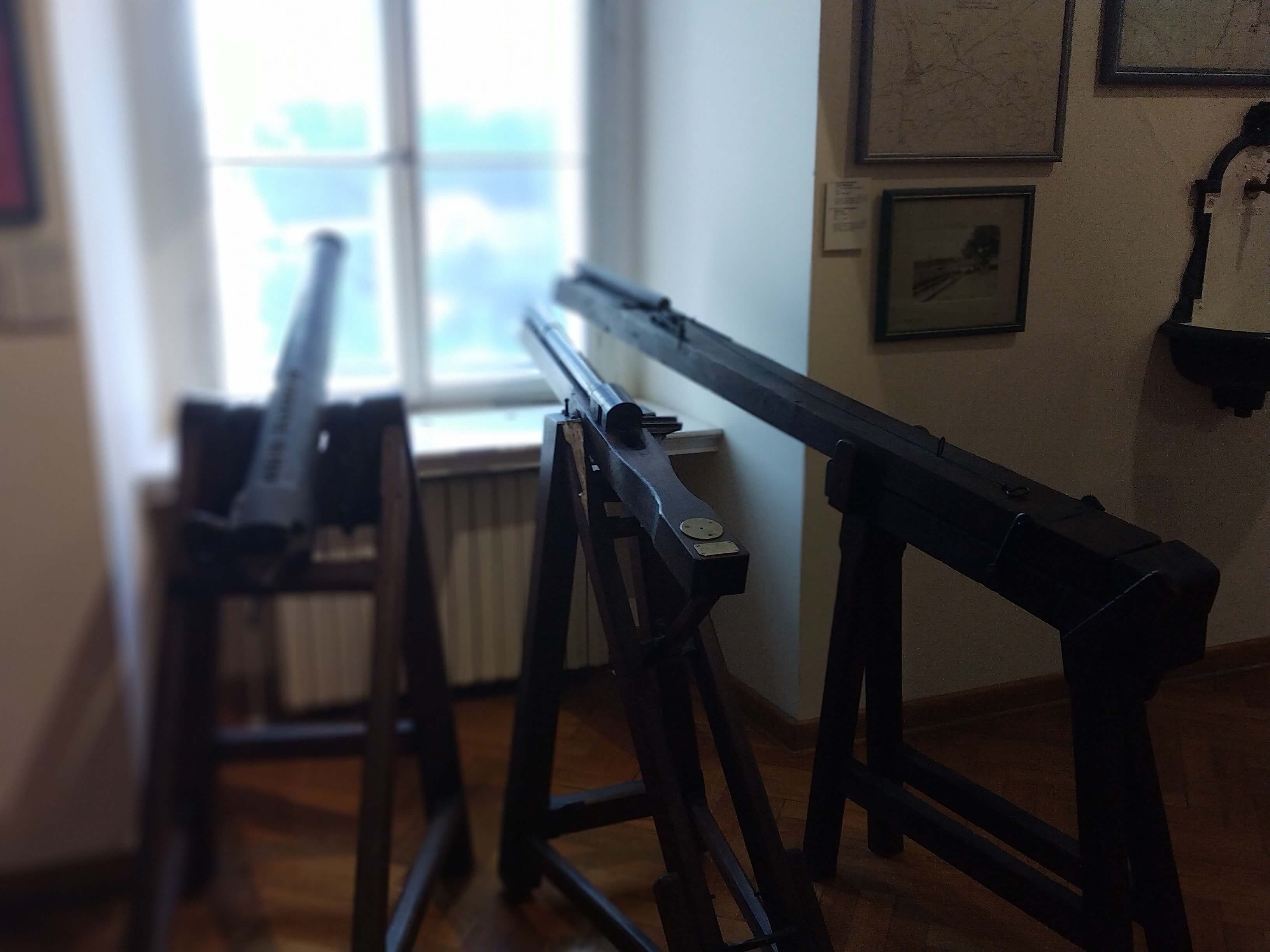
Three cannons showcased at Zagreb City Museum © Ivor Kruljac / Total Croatia News
So finding yourself in front of Fort Lotrščak (whose entrance is located right next to the Upper town funicular station) is not recognizable if you are not a fan of loud noise as it can give you a sound fright even down below at Jelačić square and the surrounding area. But, for the brave ones, the Grič cannon can provide a unique souvenir from Zagreb. It doesn't use live ammo (the cannon is modified so it can't), but it does fire several pieces of thick cardboard that then flies down to the area underneath Lotrščak's entrance and smelling like gunpowder.
Ceased fire
Despite being a regular background sound for the experience of living in Zagreb, Grič cannon went through periods when it ceased fire and stopped making statements. The first such instance was World War I and then followed by the war in the nineties. Most recently, the cannon was silenced after the Zagreb earthquake on March 22, 2020, but it re-fired hot and heavy sometimes in May 2020. However, followed by the December 29th Petrinja earthquake, which was also felt heavy in Zagreb, the cannon is silent even today.
„We are not quite sure when it will re-fire“, briefly commented the Zagreb Tourist Board member that welcomed me in Fort Lotrščak, one of the locations where Zagreb TB has a regular stand. Still, despite the cannon being silenced, you can climb and sightsee Lotrščak, the famous cannon as well as the watchtower on top of the Fort, for the prize of 20 kunas.

One of the exhibitions at Lotrščak © Kula Lotrščak
The Lotrščak Fort address is Tomićeva 9, and the Fort occasionally also hosts various exhibitions at times too. But, the cannon is a regular feature, and there are lots of info on the history of the cannon and the Fort itself there too on the walls- both in English and Croatian.
Learn more about Zagreb on our TC page.
For more about history in Croatia, follow TCN's dedicated page.
Very Slow but Sure Recovery for Croatian Private Accommodation Sector
July the 7th, 2021 - The Croatian private accommodation sector is slowly but surely recovering from the horrific blow the ongoing coronavirus pandemic and the travel restrictions dealt it. That being said, there's an extremely long way to go yet.
As Poslovni Dnevnik/Jadranka Dozan writes, among the many economic indicators that signal a solid pace of economic recovery, the most recent picture is provided by the weekly updates of fiscalisation data.
The latest data from the Tax Administration claims that last week, the value of receipts issued across all activities within the fiscalisation system stood at 19 percent higher than in the same week last year, two percent behind the comparable week of pre-pandemic 2019.
The latest figures clearly reflect the approach of the peak tourist season. Namely, in the week of the transition from June to July this year, 54 percent more receipts were reported in the tourism and hospitality industry than were reported last year. As such, when it comes to these activities, 804 million kuna of weekly turnover was reported through fiscalisation, but compared to pre-crisis 2019, that figure is still 15 percent less.
In order to get a better picture of the impact of the pandemic, the Tax Administration also offers comparisons of fiscalised turnover for the period since last year's outbreak in Croatia.
They point out that from the end of February to the end of last week, the total fiscalised turnover was 22 percent or 12 billion kuna higher than it was back during the same period last year, and two percent lower than the year before.
However, while in trade the pre-trial traffic was exceeded by four percent, in tourism and catering, the value of receipts issued in the observed more than four months is still lower by about 40 percent.
What do things look like in terms of the recovery of fiscalised turnover when we look more closely at individual activities at the level of the first half of the year?
For example, in the first six months of 2021, 1.74 billion kuna in cash turnover was recorded by the Croatian private accommodation sector (which, in addition to payments with banknotes, includes cards, cheques, etc) which is 700 million kuna more than last year, but quite far from 3.32 billion kuna from the first half of 2019. Cafes and restaurants issued invoices worth 3.75 billion kuna in the first half of the year, which has not yet caught up with 2020's realisation with slightly less than 4 billion kuna in fiscalised turnover, and the gap in relation to the semi-annual turnover from pre-pandemic 2019 stands at more than 2.9 billion kuna in total.
Among the activities that are still well behind the pre-crisis levels of activity is the category of Arts, Entertainment and Recreation, in which, after last year's 250 million kuna, the value of issued receipts recovered a litte, reaching 313 million kuna, but it is still 38 percent less than the 502 million kuna recorded in the comparable period of the last pre-crisis year of 2019.
The same applies to activities in the category of Transport and storage. After the growing cycle in 2019 resulted in more than 1.3 billion kuna in annual fiscalised turnover, last year, enterprises from these activities reported less than 770 million kuna, and the beginning of recovery this year was reflected in an increase in the value of invoices issued to 843 million kuna. Entrepreneurial niches related to tourism and travel generally fared worse than others, which shouldn't come as a particular surprise to most.
According to the NCEA, a part of these enterprises is classified in Administrative and support service activities in which fiscalised turnover is still more than half lower than in the pre-pandemic area. In the first half of the year, they reported less than 290 million kuna, or slightly less than last year's 300 kuna, while the year before, 884 million kuna in turnover was fiscalised in these activities.
For more, make sure to follow our dedicated business section.
Over Half a Million Tourists Currently in Croatia
4 July, 2021 - As Index.hr reports , Croatian Minister of Tourism, Nikolina Brnjac, published a tweet declaring over 500000 tourists currently in Croatia.
Istria and Kvarner regions, as well as Split-Dalmatia County and Zadar County are leading the list with the most guests at the moment. Considering the majority of them are coming from Slovenia, the Czech Republic, Germany, Poland and Austria, it is safe to assume most of these guests arrived by land. Airport destinations like Dubrovnik are still lagging behind in numbers, but with the recent start of Delta Air Lines and United Airlines direct flights to the city, this too is likely to change.
Dalmatian Destinations Rise
Makarska is doing well at the moment. With 6500 guests on record this popular seaside town is up a whopping 100% when compared to last year. This is still a far cry from 2019 though. This number only makes up about 50% of guests visiting Makarska in the same period two years ago.
Split is seeing the benefits of train connections to Central Europe. Since late May the city has seen direct trains to Prague, Bratislava, Vienna and most recently Budapest. Numbers at Split Airport are also rising. 160 airplanes are due to land in Split this weekend, 120 of them being commercial flights. At the same time, the Split Ferry Port is expected to receive over 40000 passengers and 11500 vehicles. Incoming tourism seems to definitely be picking up for Dalmatia's capital city.
As already mentioned, Dubrovnik is seeing two American airline companies connecting it directly to New York. Both companies started flying this week with airplanes full to capacity. This is a big step towards giving American tourists a chance to take over the position of Dubrovnik's most numerous guests from the traditionally strongest British market. Speaking of the British, they are the ones much of Croatian coast, especially Dubrovnik, are still waiting for. As of now, it is still unclear how, when and in what numbers will the British visit Croatia this year.
In the north, Rijeka region is seeing the return of Lufthansa flights as well as low-cost Eurowings flights. These will be a huge boost for the numbers from German market as the two companies now connect this part of Croatia to Frankfurt, Munich, Düsseldorf, Berlin and Hamburg.
For more on travel in Croatia, follow TCN's dedicated page.
Maritime Welfare in Croatia: Drvenik Case and What Law Says
June 25, 2021 - The issue of maritime welfare in Croatia was raised once again after a heated discussion on a beach in Drvenik Veli. Here are the details of the case and legal guidance to the maritime welfare in Croatia.
With the 2021 tourist season already being 58% better than 2020, tourists once again visit Croatia as one of the top holiday destinations.
However, like any year, the season can't go without at least some sort of incident.
Lovely beach, disgusting words
Yesterday, Croatia was shocked and enraged with the incident that happened on a beach on Drvenik Veli island (not so far from Trogir). Croatian journalist Tonka Alujević and her friend went to a beach where two Czech tourists started complaining that it's a private beach, perks of paying for a villa, and that Alujević needs to leave. Alujević refused to leave, stating that beaches are maritime welfare and cannot be privatized, refusing to move. After, as Alujević claims Czech tourists hit her head with a phone, they called the villa owner. 24 Sata daily newspaper published a video Alujević's friend recorded.
„Ma'ams, Ma'ams, how did you get here? On foot?“, asked the owner on a phone that was on speaker and held by the Czech tourists.
„I'm a journalist. Do you know Croatian laws? Do you want to end up in media?“ replied Alujević with a chill face while smoking a cigarette on a sunny day at the beach.
„Come on, put me in the media, come on put me! But first, go to the land register and see that my beach is private," screamed the owner in Croatian, with a lot of derogatory phrases (if only Czech tourists had a translator to understand the rich swear word heritage of Croatian language, right?)
The whole thing ended up with inspection stepping on the scene. Despite the video footage being clear, the owner, identified by Index.hr as Tomislav Meštrović, owner of Centovi Dvori Villa, tried to justify himself, saying everyone is welcomed at the beach, and he attacked the women because they passed through his doorway.
„No, I have no idea what video, who what... who knows what that is... I called the police for trespassing through my land“, said Meštrović to Index.hr when asked about the footage.

the conversation at the beach, screenshot/ 24sata
Law and order
Following this story, Index.hr's columnist Goran Vojković analyzed the law to clear up the issue of maritime welfare.
„The Maritime Welfare and Sea Ports Law states 'at least six meters from a line horizontally distant from the line middle waters'. But it can be wider, for example, if part of the land that in its nature or use serves to exploit the sea. It can also be narrowed- for instance, if support walls or a public road are close to the sea“, Vojković listed general rules but adding that maritime welfare border is specifically determined.
„So, the coast is free to use where the beach is, in general, six meters. You can come and use it for your needs, such as bathing, tanning, or walking. The land behind can be private, but the coast cannot“, concluded Vojković.
On the other hand, there are ways to limit the use of maritime welfare.
„There are some parts of the coast where you cannot enter. You can enter the marina and walk around it, but only until 10 pm. You cannot enter at all in a shipyard port. Those are the parts of maritime welfare for which the state assigned a concession to someone. The concession can limit or terminate public use“, explained Vojković.
Additionally, the law states that it is possible to have a beach in its concession and limit public entrance. But it needs to be registered, and the prices are so expensive that there are very few beaches like this in Croatia (Drvenik one not included in that small list).
„If someone claims that has a concession and that he/she can exclusively use some part of the coast, he needs to have a proof you can easily check in the register. I repeat, there are very small examples; even beaches in front of five-star hotels are public good“, Vojković pointed out.
And such beaches are filled with deck chairs, food stands, etc. But as Vojković pointed out, on a public beach, you have the right to bring your own deck chair, your own food, and drinks, and you can't be forced to consume content on the beach.
„In short, enjoy the Adriatic coast- with some very small exceptions of exclusive concessions, the entire coastline (including island coast) is free for your use and joy. Nobody can hold a grudge or complain if you came to a bath where they think it's 'their' beach. If someone is uncomfortable, don't debate, call authorities“, advises Vojković.
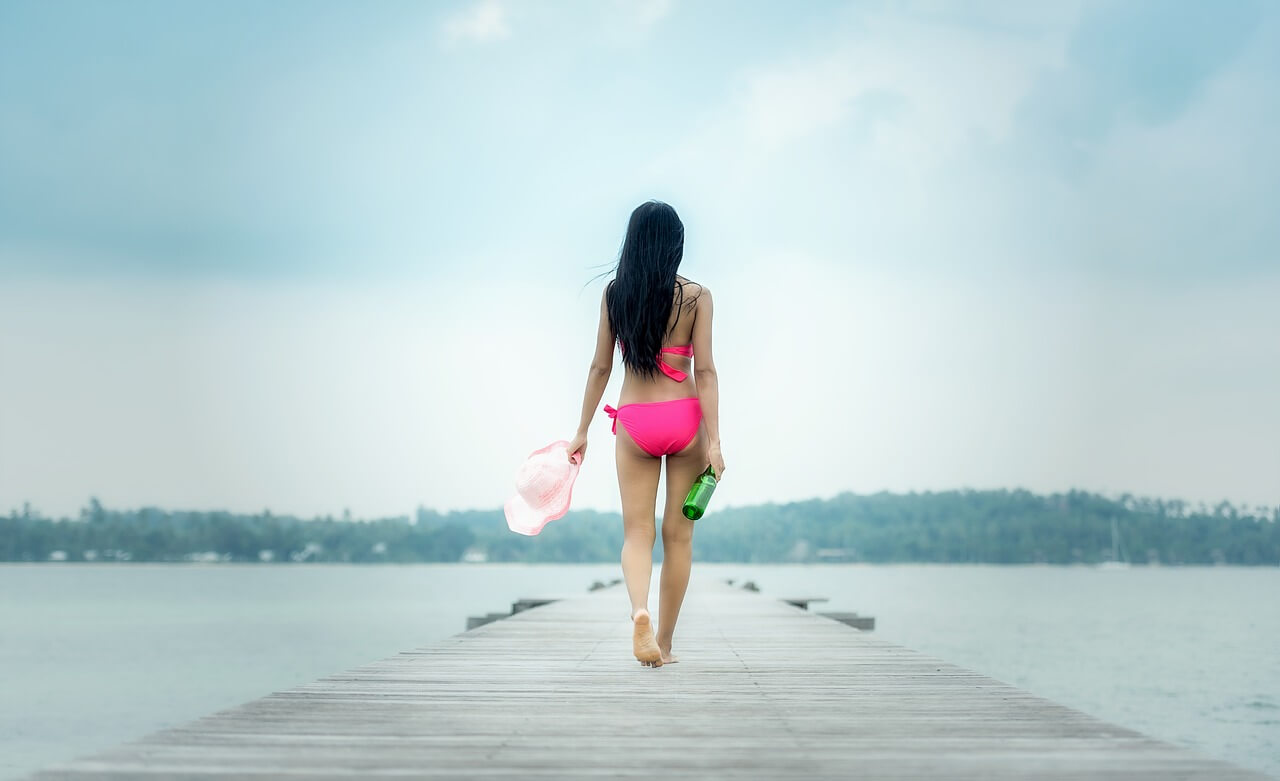
Pixabay
And the beach is open for public happily ever after
As Jutarnji List reported, the Drvenik case has a conclusion to an intriguing plot. Unhappy with Meštrović's behavior, Dalmatian locals went vigilantly and started writing bad reviews on Google, seeing the villa losing its value and tourists.
„Even though neither the building, nor its surroundings changed since the video was released, the unkindness of the owner was enough to move once-prestigious villa to the lowest grading Croatian places on Google“, says Jutarnji.
A couple of more lessons can be learned for a successful and enjoyable season from this tale.
For owners: present your offer fair in accordance with the law as transparency is the best way for your offer to beat the competition.
For tourists: if you were promised a private beach, but you see locals coming, don't be rude to them and don't attack them. The only one you can really be mad at is your host, who perhaps lied about what they can truly provide.
Learn more about beaches in Croatia on our TC page.
For more about travel in Croatia, follow TCN's dedicated page.
Adrilink Project to Boost Tourism in 7 Adriatic Countries
ZAGREB, 29 May 2021 - Adriatic states are a rich tourism whole but have a lot of untapped potential which should be promoted also outside the short and intense season, participants in a regional tourism project said in Subotica, Serbia on Saturday.
Landscape Days, held in the Zasavica Special Nature Reserve near Sremska Mitrovica, are part of the Adrilink project which encompasses ten partner cities in seven Adriatic countries - Italy, Slovenia, Croatia, Bosnia and Herzegovina, Serbia, Albania and Greece.
The project partners in Croatia are the municipality of Mošćenička Draga and the town of Vrsar.
"The goal is a common vision of the landscape as a driver of the local development of the Mediterranean-Adriatic-Ionian economy, and the project envisages using modern information and communication technology to promote new destinations among tourists by making them more attractive, and to extend the season," said Svetlana Sabo, a member of the project team.
The Adrilink project lasts from 1 February 2020 to 31 July 2022, and one of its results should be a sustainable common strategy, new common itineraries, and linking ten interpretation centres in the seven countries though an app and a digital platform.
The goal is to offer tourists new challenges and the discovery of new natural and cultural landscapes such as nature reserves and the historical and cultural heritage.
OPG Čudesna šuma: Paradise Reimagined in Beautiful, Traditional Baranja
May 13, 2021 – OPG Čudesna šuma: How an unexpected turn of events helped world-renowned photographer Mario Romulić realise his lifelong dream.
War and genocide and the aftermath. Famine. Disease. Death. In a former life, harrowing images filled the lens of internationally renowned photographer Mario Romulić. But thankfully, we're now far from such scenes.
In fact, at OPG Čudesna šuma - Mario Romulić's home and family farm - we're pretty much far from everything. One other eco-farm is his only neighbour. Well, unless you count the llamas the Romulić family keep out back. Occasionally, through the rich green of surrounding trees, you see birds flying above the branches. Probably they're toing and froing from Kopački rit. The nearby Nature Park is less than a kilometre from OPG Čudesna šuma. Famously, the wetlands are home to over 250 species of birds. They are also the reason why Mario Romulić is here.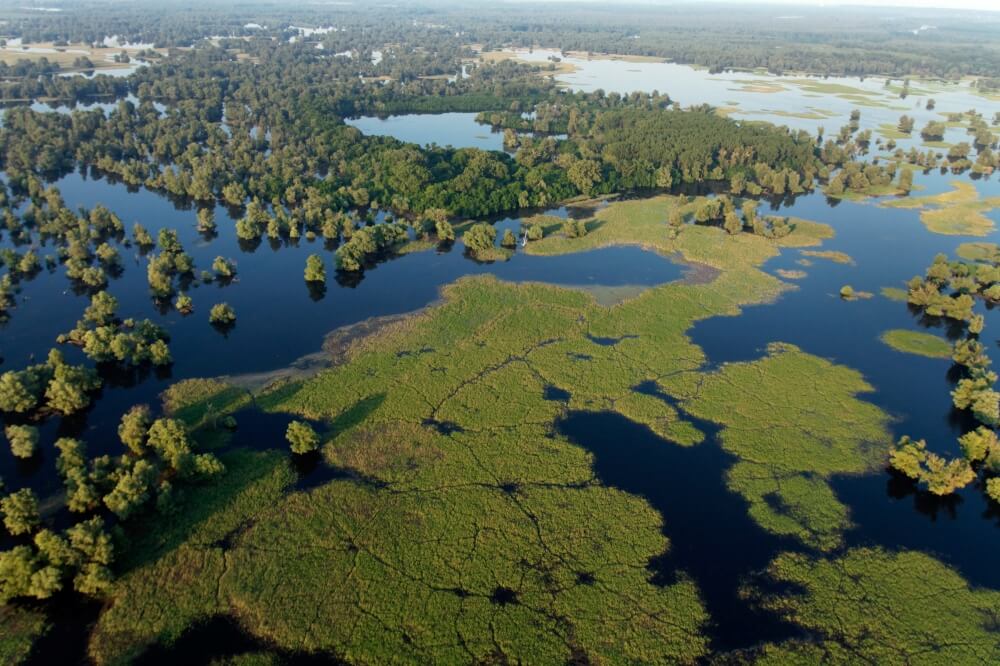 Kopački rit Nature Park © Kopački rit Nature Park.
Kopački rit Nature Park © Kopački rit Nature Park.
“Back then, I was very occupied with Kopački rit,” remembers Mario of the time, 21 years ago, when he moved to what is now OPG Čudesna šuma. “I was working as a cameraman for people like Reuters, all over the world. The assignments would last 7-10 days and I'd be in places like Afghanistan, Rwanda, Congo, Liberia, Bosnia. It was often quite dangerous. For the next 20 days, I would spend a lot of time in Kopački rit, trying to calm my nerves. It was something like a cure after seeing all these horrible scenes. Eventually, instead of travelling every day from my home in Osijek to Kopački rit, I decided to try and find something close by. And this is what I found.”
Just as this beautiful, natural landscape in Bilje, Baranja once served as a peaceful getaway for Mario Romulić, his OPG Čudesna šuma today does the same for others. Because, after dreaming for two decades of turning this blissful plot and homestead into a forest farm and eco-village, Mario Romulić is finally turning that vision into a reality.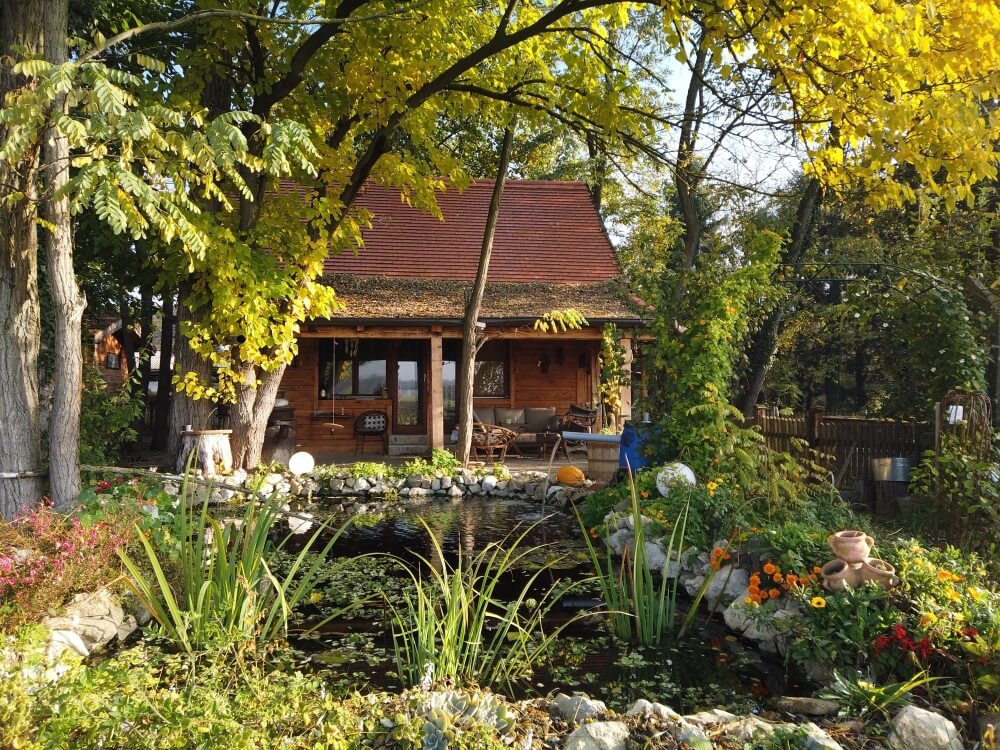 The impossibly pretty OPG Čudesna near Kopački rit Nature Park, Bilje Municipality, Baranja © OPG Čudesna šuma.
The impossibly pretty OPG Čudesna near Kopački rit Nature Park, Bilje Municipality, Baranja © OPG Čudesna šuma.
“Because of my job - first, travelling all around the world, then travelling Croatia - I did not even have much time to think about it, let alone do it,” says Mario. “But, then Corona came. Finally, I found myself at home. At last, I had time to work on my dream.”
OPG Čudesna šuma in the Month of Baranja Cooking (Mjesec baranjske kuhinje)
A group of 30 or so are Mario's guests today at OPG Čudesna šuma. They're here for a presentation of speciality cooking. It's the grand finale of the Month of Baranja Cooking (Mjesec baranjske kuhinje).
Over previous weeks, OPGs from all across the region have welcomed guests to try goulash, soups, stews, perklet and other traditional foods of the area. While visiting, they've been embraced by the beautiful landscape of Baranja. Not only have they discovered how this delightful, distinct cuisine tastes, but also they've learned exactly how it's prepared. However, they've evidently saved the best for last. On the menu today, river fish inventively cooked, accompanied by a riotous rainbow of seasonal vegetables. Seasonal vegetables of Baranja in springtime at the Month of Baranja Cooking (Mjesec baranjske kuhinje) © OPG Čudesna šuma.
Seasonal vegetables of Baranja in springtime at the Month of Baranja Cooking (Mjesec baranjske kuhinje) © OPG Čudesna šuma.
It's a beautifully sunny day, right at the start of May. It depends on your preference, but looking across this happy vista in the glorious sunshine, it's difficult to imagine this not being the perfect time to be in Baranja. Young children are raised to chest height by their parents so they can meet Mario's free-roaming llamas face-to-face. The children's faces flit between surprise, curiosity and delight. The llamas return their stare. They're used to welcoming new guests. Meeting the Romulić family llamas at OPG Čudesna šuma © Turistička zajednica Općine Bilje - Kopački rit.
Meeting the Romulić family llamas at OPG Čudesna šuma © Turistička zajednica Općine Bilje - Kopački rit.
Partially shaded by trees, the smiling adult guests sit casually on wooden benches around a central, outdoor cooking area. Several open fires display a range of traditional cooking methods. Steam rises from a cast-iron stove suspended over one. Beneath the vapours, you can make out the dish is fish paprikash. It's unmistakable because of the deeply red coloured bubbles, a result of generous amounts of paprika.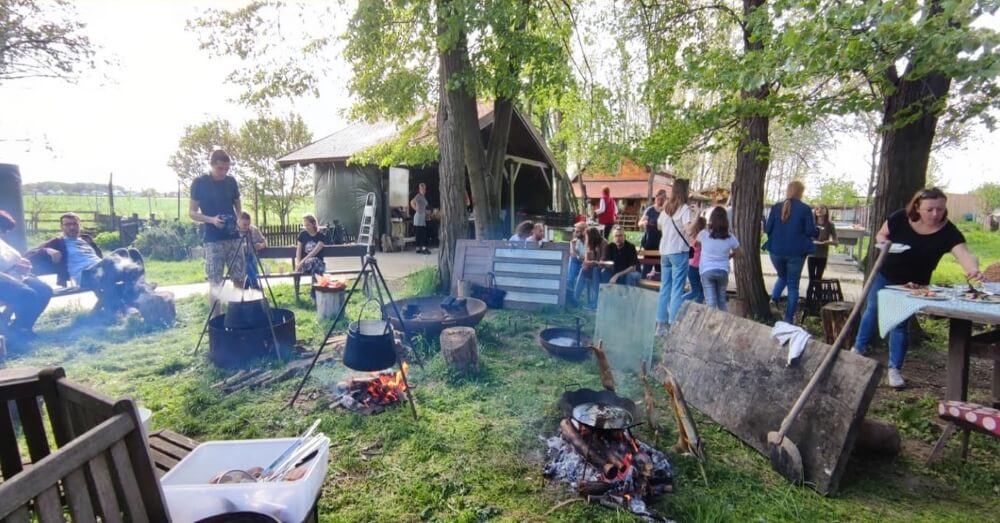 Guests enjoy a warm springtime day at OPG Čudesna šuma during the Month of Baranja Cooking (Mjesec baranjske kuhinje), as fish paprikas cooks over an open fire © OPG Čudesna šuma.
Guests enjoy a warm springtime day at OPG Čudesna šuma during the Month of Baranja Cooking (Mjesec baranjske kuhinje), as fish paprikas cooks over an open fire © OPG Čudesna šuma.
A huge bag of this paprika sits propped up, close by. It's from another organic OPG, just a kilometre or so from here. The colour is vivid, impossibly red, unrecognisable from anything store-bought. At the next fire, pike impaled on wooden sticks are placed far enough from the flickering flames so they cook slowly and do not burn.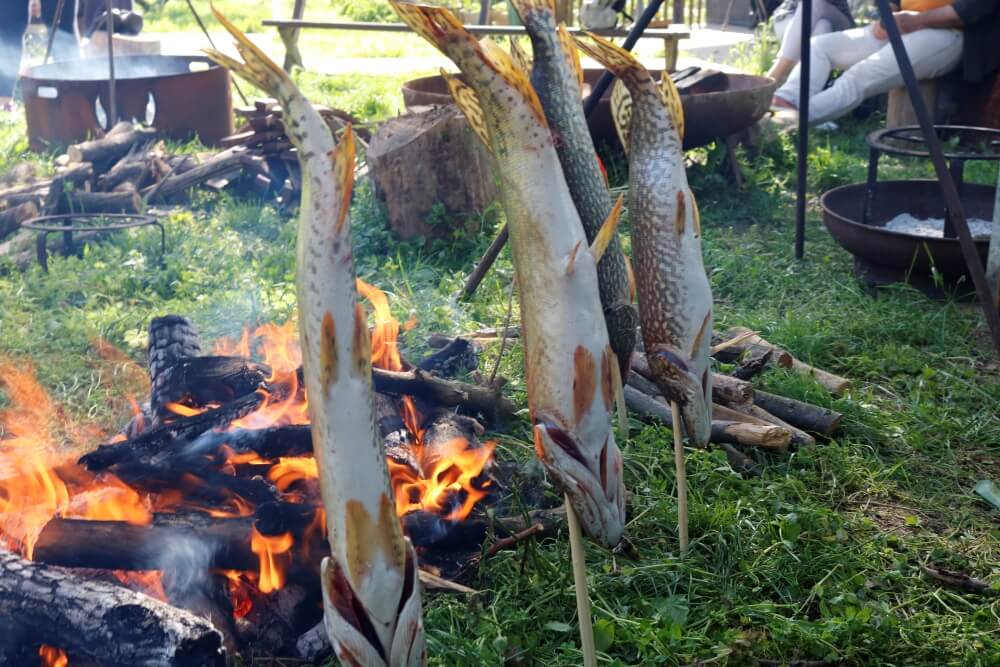 Pike impaled on sticks, cooking by an open fire at OPG Čudesna šuma @ Marc Rowlands.
Pike impaled on sticks, cooking by an open fire at OPG Čudesna šuma @ Marc Rowlands.
In the outdoor kitchen, Mario Romulić's co-chefs prepare an unending supply of fish dishes and vegetables. Carp, catfish, trout, bream. There's a bounty of fresh asparagus. It's that time of year. With the restraint of experience, they've cooked it perfectly. After the crunch of the bite, the flavour explodes. They're seasoned simply – delicious olive oil and sea salt.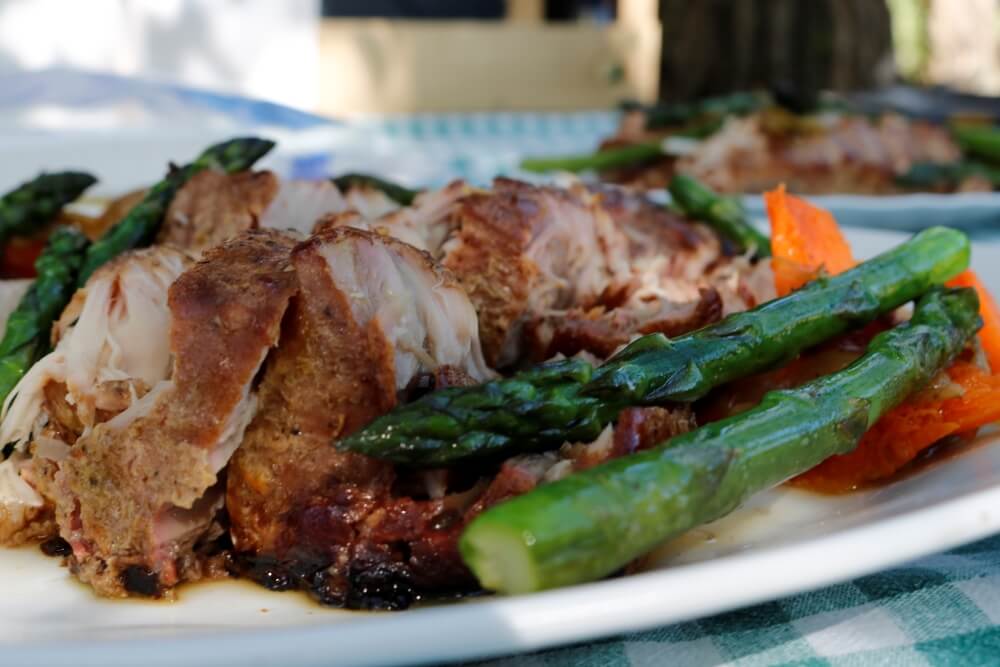 Seasonal asparagus, perfectly cooked, served with smoked river fish © Marc Rowlands.
Seasonal asparagus, perfectly cooked, served with smoked river fish © Marc Rowlands.
A group of peers – accomplished chefs from Osijek-Baranja restaurants – peak over the shoulders of Romulić's co-chefs. They're admiring the inventive techniques employed. Although, being chefs, they can't help themselves. They end up briefly forgetting their families in order to help out.
Mario Romulić, the host with the most
 Mario Romulić © Turistička zajednica Općine Bilje - Kopački rit.
Mario Romulić © Turistička zajednica Općine Bilje - Kopački rit.
After all the guests arrive, Mario Romulić holds court. Cheerily he welcomes us all to OPG Čudesna šuma and the event. Without question, the success of rural, village tourism depends on the personalities of the hosts. It's no good plonking a group of visitors in a pretty place and throwing some food in front of them. We've all seen trees, grass and food before. Rural tourism is not just about the place, it's about the experience, the ambience. And, especially, it's about the people.
Hands down, the OPGs of Slavonia and Baranja are the best in Croatia at this. The folks here are famous for their friendliness, warm welcome and big personalities. And, Mario Romulić has one of the biggest of them all.
In the research for this reportage, looking back at archive pictures of Mario Romulić is startling. During his years spent as an international photographer, he himself has been photographed many times – on assignment in distant countries, at the opening of exhibitions that have showcased his celebrated work. In most, there's an intensity to his stare. It's sometimes difficult to look at. He looks like a man who has tales you never want to hear, like a man who has seen too much.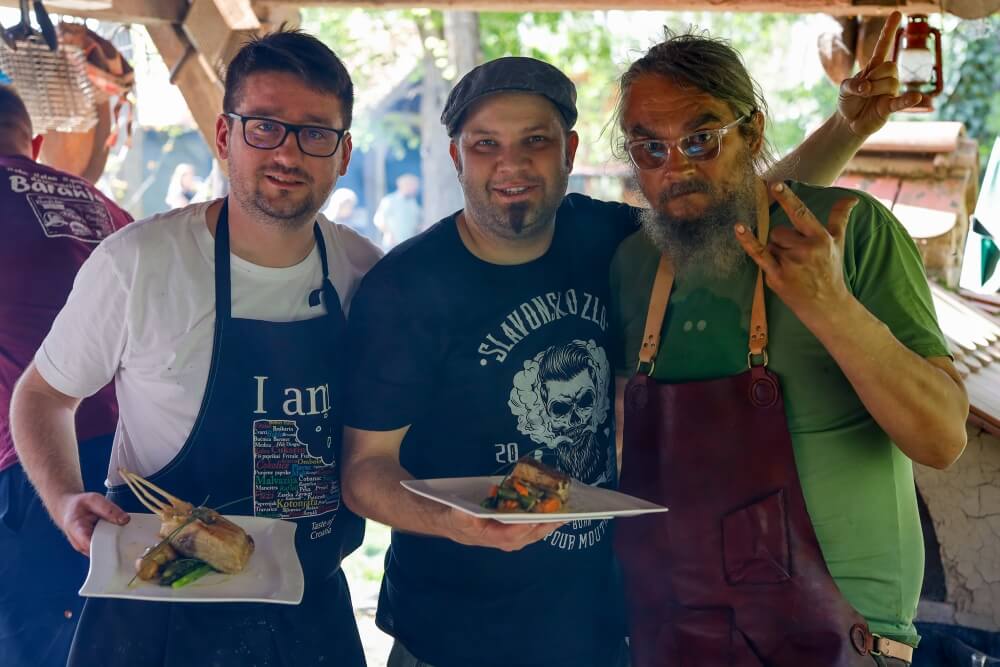 (L- R) OPG Čudesna šuma co-chef at the event Mihael Tomić, renowned Osijek chef Ivan Đukić currently of Osijek's Lipov Hlad and a happy Mario Romulić © Turistička zajednica Općine Bilje - Kopački rit.
(L- R) OPG Čudesna šuma co-chef at the event Mihael Tomić, renowned Osijek chef Ivan Đukić currently of Osijek's Lipov Hlad and a happy Mario Romulić © Turistička zajednica Općine Bilje - Kopački rit.
By comparison, the Mario Romulić that welcomes us at OPG Čudesna šuma today is unrecognisable. Sure, there's a little more grey to his long hair and beard but, otherwise, he looks incredibly healthy and happy. The intense stare is gone, replaced by a warm, wide smile that shows across his entire face. Even in early May, he has a darkened skin tone, the telltale signs of a man who spends much of the day outdoors. Romulić's enthusiasm for his guests and the event is palpable. After his sincere welcome, this enthusiasm is immediately transferred to each of his guests.
Mrs Romulić ensures everyone's glass is overflowing with wine or juice. One of Mario's teenage sons helps out with the food, while the other is taking photographs of the event. Well, someone has to do the photography now that dad wants to be a chef and host! Mario himself is engulfed in smoke. Among the other duties he's assumed today, Mario is tending a smoker. Without a doubt, this is the most revelatory cooking method we meet today.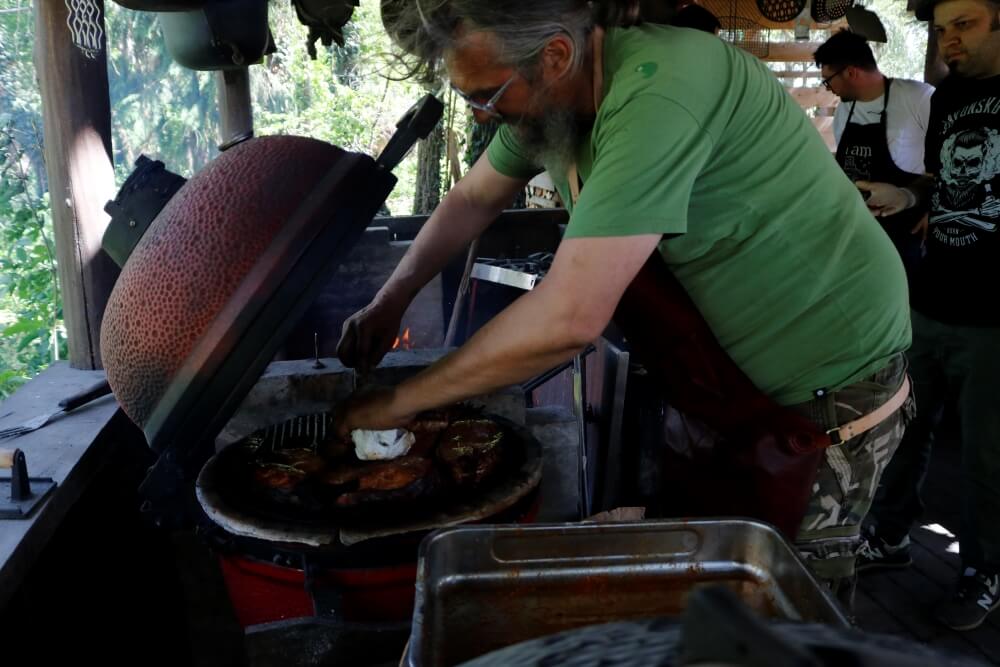 Mario Romulić tends to smoked river fish, a revelatory gastronomic experience at OPG Čudesna šuma © Marc Rowlands.
Mario Romulić tends to smoked river fish, a revelatory gastronomic experience at OPG Čudesna šuma © Marc Rowlands.
Smoked fish of Slavonia and Baranja at OPG Čudesna šuma
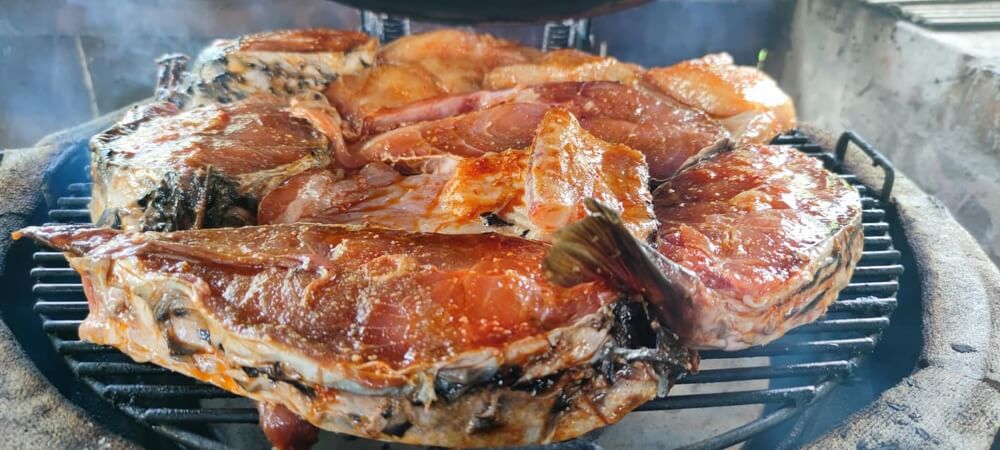 An American-style smoker, loaded with river fish. TOP TIP: A great way to stop fish sticking to the grill of your barbecue or smoker is to place them on top of a layer of lemon slices © OPG Čudesna šuma.
An American-style smoker, loaded with river fish. TOP TIP: A great way to stop fish sticking to the grill of your barbecue or smoker is to place them on top of a layer of lemon slices © OPG Čudesna šuma.
“We do have smoked fish here, but not in this way,” he says. “This is more like an American grill. I never heard of anyone trying Baranja cooking like this. Actually, I never heard of anyone nearby who has a smoker like this. The first time I tried stuka (pike) in the smoker, that was unbelievable. It's incomparable, really special.” Exquisite presentation of river fish by the enthusiastic team of OPG Čudesna šuma © Turistička zajednica Općine Bilje - Kopački rit.
Exquisite presentation of river fish by the enthusiastic team of OPG Čudesna šuma © Turistička zajednica Općine Bilje - Kopački rit.
“In Slavonia and Baranja, there are just a few ways we usually cook our river fish - carp on sticks, fish paprikash, perklet and fried fish. So, we tried something new, to expand the palette. For instance, almost nobody eats Babuška (a type of carp). They feed it instead to their pigs. It costs 5 kuna a kilo! But, if you cook it in this completely natural way, it's delicious.”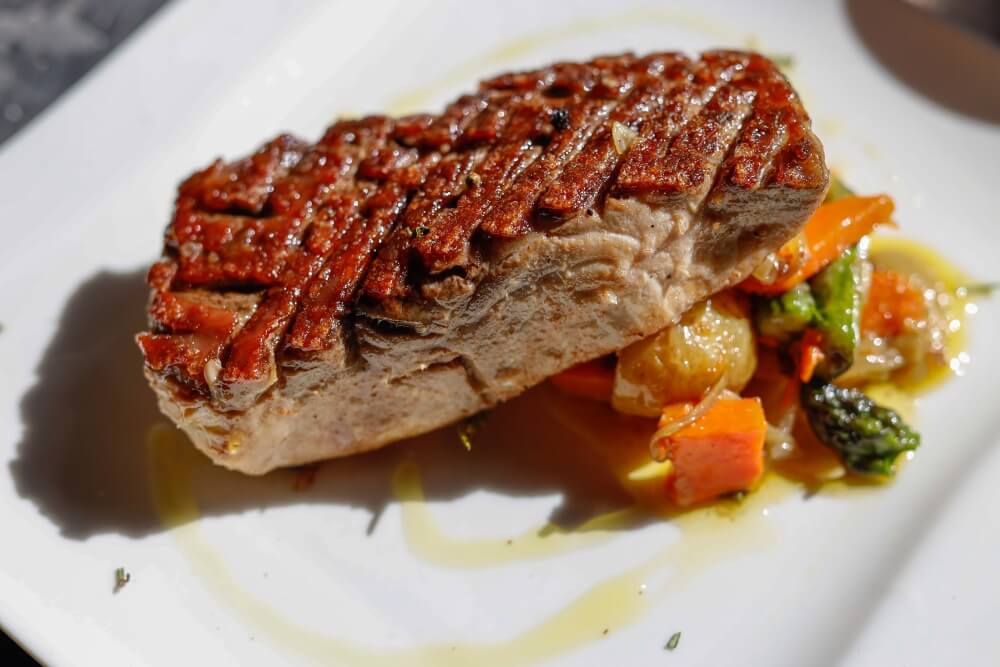 More river fish, cooked by the team of OPG Čudesna šuma © Turistička zajednica Općine Bilje - Kopački rit.
More river fish, cooked by the team of OPG Čudesna šuma © Turistička zajednica Općine Bilje - Kopački rit.
He's not wrong. Today's mountain of different smoked fish is the talk on most of the adult lips. The rich flavours surprise. Compliments and returns for second helpings ensue. Mario stands to one side, happily watching as his smoked fish secret escapes. In the future, he plans similar events based on other regional foods - Black Slavonian pig, wild meats like deer or boar. Eventually, in the seven hectares of land he owns here, he would like to expand OPG Čudesna šuma as an eco-village, with beds for visitors, a natural swimming pool and then surround it with a food forest. Big plans. It looks as though the camera may stay more permanently in the hands of his son. Because it's difficult to imagine Mario Romulić leaving his happy place and the realisation of his long-held dream. Mario Romulić in his happy place, with a friend © OPG Čudesna šuma.
Mario Romulić in his happy place, with a friend © OPG Čudesna šuma.
Both the author and Total Croatia News would like to thank the following for their invaluable help in creating this article: Ivana Jurić and the Tourist Board of Osijek-Baranja County, OPG Čudesna šuma, Mario Romulić and family, Renata Forjan and Turistička zajednica Općine Bilje - Kopački rit and Domagoj Butković of expert travel guides to Slavonia and Baranja, Kulen travel.
Krka National Park Ticket Discount: Walk for a 20% Cheaper Visit in May
April 30, 2021 - Throughout the month of May, a Krka National Park ticket discount is going to be offered in the Park's "Go and Walk" action, which provides a 20% cheaper ticket to any visitor ready to enter and exit the premises on foot.
Krka National Park, as stated on their website, is going to be inviting visitors to enter the Park on foot and get a 20 percent discount on their individual ticket price for doing so. This offer is part of the ''Go and Walk'' action, which starts on Saturday, May the 1st, and is set to continue throughout the whole month.
''The ''Go and Walk'' promotional action implies that people must enter and exit the park on foot in order to get the Krka National Park ticket discount of 20%. All of the park's other services, as well as tickets for visitors who will enter the park by boat or a bus, will be charged by as normal,'' according to Krka National Park's official website.
The discount varies pending on where you intend to go. If you decide to go to the main spectacle of the park, The Skradinski Buk waterfall by taking the hitchhiker trail, either from Lozovac or Skradinski Bridge, the promotional price is 80 kuna. Apart from Skradinski Buk, all other land localities in the park are set to be included in that price. Kids aged 7-18 accompanied by parents or guardians will have to pay only 64 kuna for their ticket, while for kids up to the age of 7, entrance to the park is free of charge.
If you decide to walk only until Roski Slap, an adult ticket will cost 40 kunas and for kids (7-18-year-olds), only 32 kuna.
The third option is also the Krka Monastary and Burnum archaeological site. An adult ticket price for that path is 32 kuna, while the children's ticket costs a mere 24 kuna.
''With the ''Go and Walk'' action, the Public Institute of Krka National Park wants to encourage the active visiting of the park, and the usage of educational-hitchhiking trails too, by reducing the usage of public transport by bus and boats and having a direct impact on lowering CO2 emissions,'' said Nella Slavica of the Public Institute of Krka National Park.
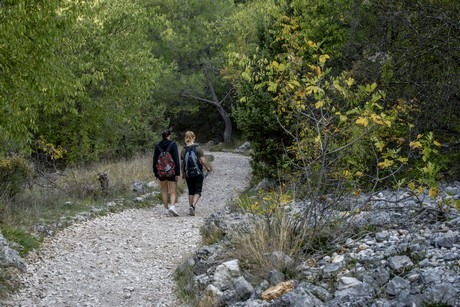
© Krka National Park
Krka National Park is also a holder of the ''Stay Safe in Croatia'' badge, and the park is being very careful in ensuring epidemical measures are respected by both the visitors and employees while informing the public about the benefits of being out in the open air during these challenging times.
Back in the former Yugoslavia, on January the 24th, 1985, the Parliament of the Socialist Republic of Croatia declared Krka a National Park, and it has enjoyed an enormous amount of popularity ever since. This gorgeous park remains a place of natural and cultural heritage, a place to learn, a place to rest, and a place to enjoy a lovely escape from the stress of modern life.
Learn more about Krka National Park on our TC page.
For more about travel in Croatia, follow TCN's dedicated page.


